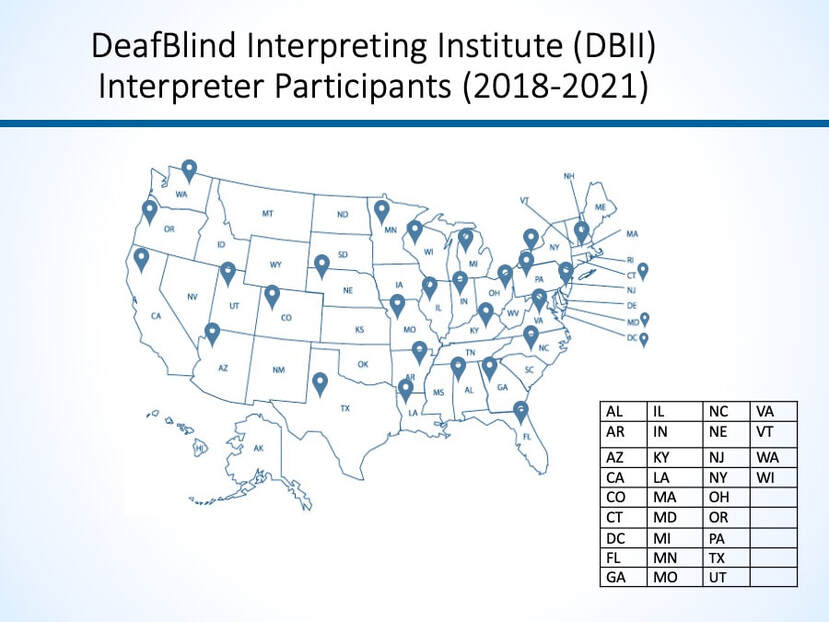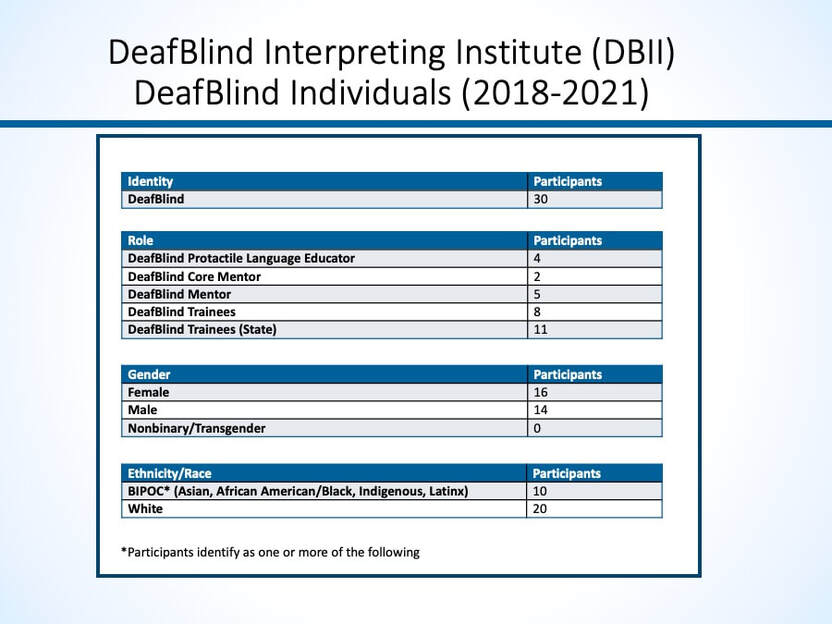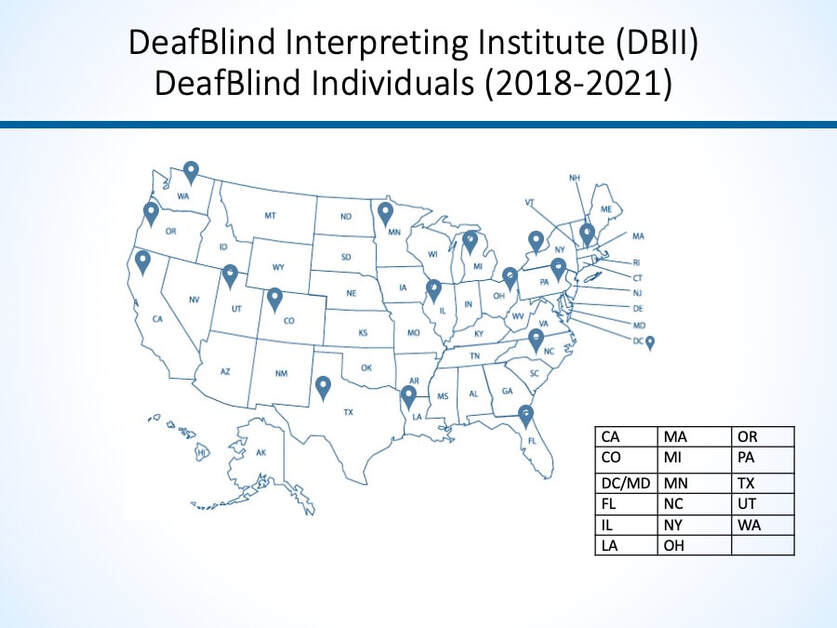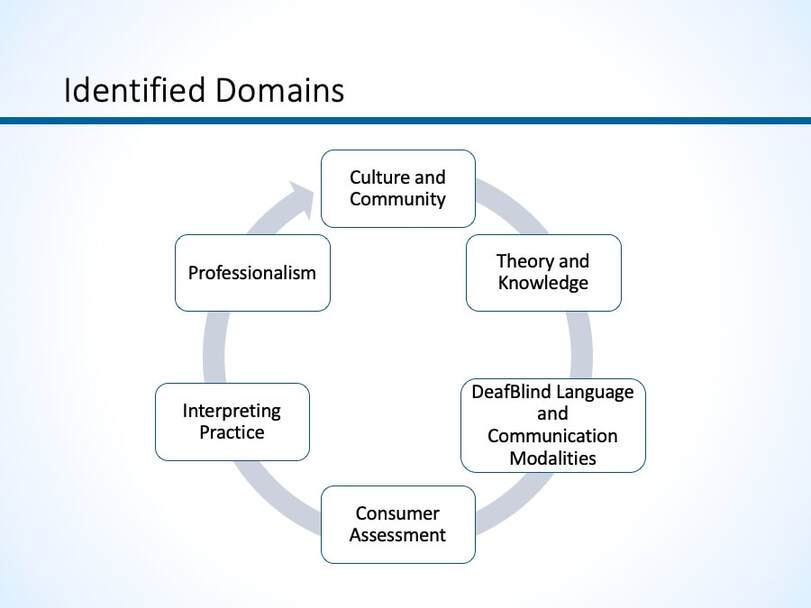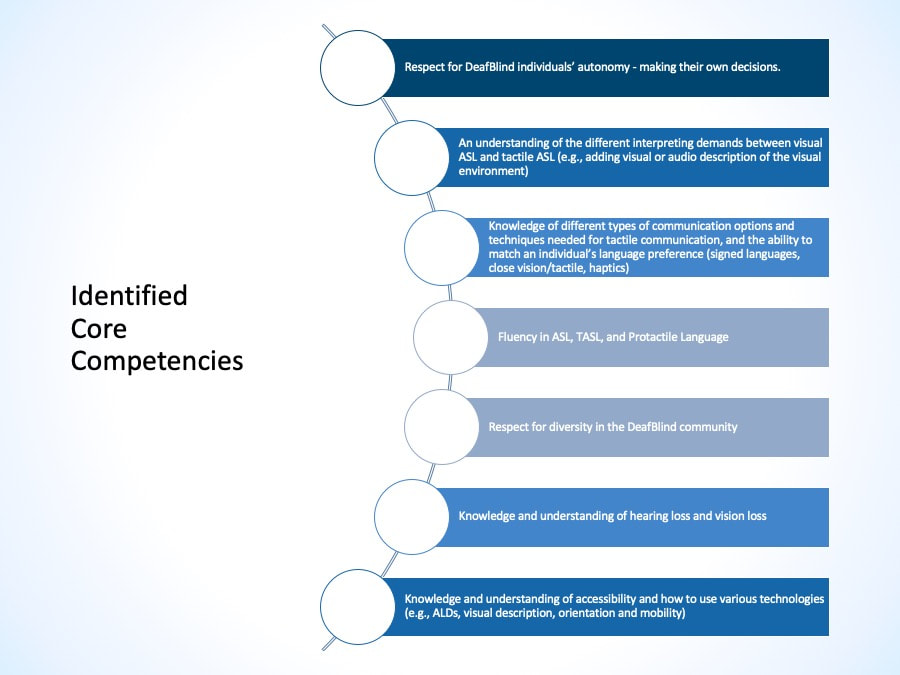To download a copy of this DBI and FAQs page, click the file below.
| dbi_faq_page.docx | |
| File Size: | 175 kb |
| File Type: | docx |
The DeafBlind Interpreting National Training & Resource Center (DBI) is in the fifth year of a five year grant cycle (2017-2021). Over the course of the past five years, research has demonstrated that Protactile Language continues to diverge linguistically from American Sign Language. This grant was funded to establish a baseline of skills and competencies an interpreter must possess to effectively work with DeafBlind consumers who use Protactile Language.
This grant is funded by the Rehabilitation Services Administration (RSA), a federal agency embedded within the U.S. Department of Education, and is primarily an interpreter training grant. At the end of 2021, we must be able to report on the following measures:
- The total number of working interpreters enrolled in specialized training.
- The total number and percentage of working interpreters who successfully completed specialized training.
- The total number and percentage of working interpreters who successfully completed specialized training and subsequently obtained employment in the area(s) for which they were prepared.
- The total number and percentage of working interpreters who successfully completed specialized training and subsequently advanced in employment in the area(s) for which they were prepared.
In 2017, when DBI was first funded, DeafBlind leaders and educators already knew they were using a language that was different from visual ASL, but peer-reviewed research is slow-going, and it took time for evidence of this divergence in language to be published. As a federally funded grant project, we are obligated to adhere to evidence-based practices, and to ground all of our work in peer-reviewed research. As additional research emerged on Protactile Language, DBI updated its pedagogical approaches and teaching materials to reflect this new evidence. This means, each year, the required skills and competencies for DeafBlind Educators, DeafBlind Mentors, and Interpreter participants changed to better reflect what was being demonstrated in the research.
Over the course of the past four years, DBI has collected data on every component of our program. This data was used to review, edit, and improve our practices. Every year, DBI participated in an Annual Performance Report (APR) review with our federal Project Officer to ensure we were on target to meet all required measures of the grant. In addition to the four measures listed above, which are specific to the federal government (GPRA: Grant Performance and Results Act), DBI also must meet other program and project measures that were established in the original grant application.
In 2019, DBI participated in a federal 3+2 Review that consisted of professionals in leadership from different federal departments and agencies. During this review, we had to demonstrate how we were meeting or exceeding all required measurements of the grant. During our presentation, people were so excited about the impacts coming out of DBI that we had an influx of people coming and going over the course of the two days. On the second day, Mark Schultz, Acting Secretary of Office of Special Education and Rehabilitation Services (OSERS), as well as the Commissioner for Rehabilitation Services Administration (RSA), joined our review and congratulated DBI on the efforts to establish a baseline for interpreters in this field.
DBI acknowledges that the work that has been done over the past 5 years only scratches the surface of what needs to be done in the field of interpreting related to Protactile Language. As more research shows evidence that Protactile Language is distinct and is diverging from visual ASL, it is clear that short-term training for interpreters is no longer enough.
We believe that more DeafBlind individuals need access to DeafBlind Educators who are fluent in Protactile Language. When more DeafBlind individuals become fluent in Protactile Language, they will be able to work with their local interpreting communities to provide language education and acquisition opportunities.
This grant established a baseline for evidence-based practice in the field of Protactile Language interpretation and DeafBlind Protactile Mentorship. This document provides a summary of the work that has been done over the past five years.
DBI: DeafBlind Interpreting National Training & Resource Center
DBII: DeafBlind Interpreting Institute is a 100-hour intensive and rigorous hybrid training program that consists of online and onsite instruction and a post-onsite induction.
Q1: Who is DBI funded by?
A: RSA Grant H160D160005. DBI is a grant funded by the US Department of Education RSA CFDA #84.160D, and is a project under the Regional Resource Center with Deaf communities at Western Oregon University.
Q2: When did DBI start/When will DBI end?
A: This grant was funded in 2017. It is a five year grant and will end in December 2021.
Q3: Where can I find a copy of the 2017 National Needs Assessment?
| dbi_toward_effective_practice_2018.pdf | |
| File Size: | 2867 kb |
| File Type: | |
Q6: What are the core competencies for DeafBlind Protactile Mentors?
DeafBlind onsite mentors must demonstrate competency in the following areas:
- Autonomy
- Fluency in Protactile Language
- Demonstration of the 7 Principles of Protactile Language
- DBI Philosophy and Teaching Pedagogy
- Mentoring
- Interpreter Evaluation and Assessment
Q7: What are the DBII participant requirements for interpreters?
- Minimum of 3+ years as a working interpreter
- Fluency in ASL and willingness to learn Protactile language
- Understanding of the impact of sighted/hearing power and privilege dynamics and recognition of the fundamental value of touch-based communication as the language of information and power among the DeafBlind community
- Ability to accept feedback from experienced interpreters and DeafBlind trainers and mentors
- Certification is not required
- Live and engage in geographic locations with DeafBlind communities who use Protactile Language
Q8: What are the dbii participant requirements for DeafBlind Mentors?
- Possess a strong knowledge of Protactile Language.
- Possess a strong DeafBlind identity and personal autonomy.
- Be able to maintain and establish consistent PT-space and refrain from sight-reliance as primary means of communication and orientation.
- Possess interpersonal and relational "soft" skills with other educators, mentors, DBI staff, and interpreter participants.
- Can understand and demonstrate the role of a mentor. Have a clear understanding of how to give friendly and supportive feedback for learning and growth (and not criticize or diminish the interpreter participant's effort) in a conversational, in-the-moment way.
- Successfully show mastery of core Protactile Language competencies.
- Be responsive to emails and/or text messages in a timely manner.
- Maintain a positive "I can" attitude.
- Maintain confidentiality about training content and concerns with participants and/or other mentor trainers
Q9: How many interpreters Must complete DBII training between 2018-2021?
120 interpreters must be trained by the end of 2021. DBII exceeded this goal by training over 150 interpreters.
Q10: How many DeafBlind Educators/Mentors must complete DBII training?
30 DeafBlind individuals must be trained by the end of 2021.
Q11: How many hours of training do interpreters receive?
Total DBII Program Hours
Providing 100 total hours, the equivalent of 10 CEUs.
*The final hours for the 2020-2021 DBII Cohorts will be determined at the end of 2021.
- 30 hours of online community of practice
- 60 hours of onsite training
- 10 hours of induction experience
Providing 100 total hours, the equivalent of 10 CEUs.
*The final hours for the 2020-2021 DBII Cohorts will be determined at the end of 2021.
Q12: How many hours of training did DeafBlind mentors receive?
- Initial mentor training: 40 hours
- Refresher mentor training: 15 hours
A total of 55 hours of training for mentors hired to work with DBII.


